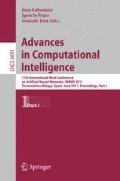Abstract
In this paper, we study how a biologically-plausible cerebellum architecture can store and retrieve different robotic-arm internal models (in synaptic connections between granular layer and Purkinje cells) at the granule layer (dynamic modifications of a base robot-arm-plant model), and how the model microstructure and input signal representations can efficiently infer models in a robot control scenario during object manipulation. More specifically, we have evaluated the contribution of the granular layer to the ability of the cerebellum to generate corrective actions. To achieve this we have embedded a spiking cerebellar model into an analog control loop whose output commands a simulated robot arm. The performance results obtained by using a cerebellum which includes granular layer are compared to those using a cerebellum without this layer. The results show that this layer effectively contributes to the generation of accurate cerebellar corrections. This work represents a well defined case of study in the field of neurobotics, in which biologically plausible neural systems and robots are used to study the functionality of biological systems.
Access this chapter
Tax calculation will be finalised at checkout
Purchases are for personal use only
Preview
Unable to display preview. Download preview PDF.
References
Kandel, E.R., Schwartz, J.H., Jessell, T.M.: Principles of Neural Science. McGraw-Hill Professional Publishing, New York (2000)
Schweighofer, N., Doya, K., Lay, F.: Unsupervised learning of granule cell sparse codes enhances cerebellar adaptive control. Neuroscience 103(1), 35–40 (2001)
Coenen, O.J.-M.D., Arnold, M., Courchesne, E., Jabri, M., Sejnowski, T.: A hypothesis for parallel fiber coding in the cerebellum. Society for Neuroscience Abstracts 25 (1999)
Coenen, O.J.-M.D., Arnold, M., Sejnowski, T., Jabri, M.: Parallel fiber coding in the cerebellum for life-long learning. Autonomous Robots 11(3), 291–297 (2001)
Jorntell, H., Hansel, C.: Synaptic memories upside down: bidirectional plasticity at cerebellar parallel fiber-Purkinje cell synapses. Neuron. 52, 227–238 (2006)
Meunier, C., Nadal, J.-P.: The Handbook of Brain Theory and NeuralNetworks. MIT Press, Cambridge (1995)
Brunel, N., Hakim, V., Isope, P., Nadal, J.P., Barbour, B.: Optimal information storage and the distribution of synaptic weights: perceptron versus Purkinje cells. Neuron. 43, 745–757 (2004)
Barbour, B.: Synaptic currents evoked in Purkinje cells by stimulating individual granule cells. Neuron. 11(4), 759–769 (1993)
Ros, E., Carrillo, R.R., Ortigosa, E.M., Barbour, E.M., Agís, B.: Event-Driven Simulation Scheme for Spiking Neural Networks Using Lookup Tables to Characterize Neuronal Dynamics. Neural Computation 18, 2959–2993 (2006)
Carrillo, R.R., Ros, E., Boucheny, E., Coenen, C.: A real-time spiking cerebellum model for learning robot control. Biosystems 94(1-2), 18–27 (2008), http://edlut.googlecode.com
Butterfaß, J., Grebenstein, M., Liu, H., Hirzinger, G.: DLR Hand II: next generation of a dextrous robot hand. In: IEEE International Conference on Robotics and Automation, pp. 109–114 (2001)
Hirzinger, G., Butterfab, J., Fischer, M., Grebenstein, M., Hähnle, M., Liu, H., Shäfer, N., Sporer, I.: A mechatronics approach to the design of light-weight arms and multifingered hands. In: ICRA, pp. 46–54 (2000)
Kettner, R., Mahamud, S., Leung, H., Sittko, N., Houk, J., Peterson, B., Barto, A.: Prediction of complex two-dimensional trajectories by a cerebellar model of smooth pursuit eye movement. Journal of Neurophysiology 77(4), 2115–2130 (1997)
Haith, A., Vijayakumar, S.: Robustness of VOR and OKR adaptation under kinematics and dynamics transformations. In: Proceedings of 6th IEEE international conference on development and learning (ICDL 2007), London (2007)
Hoffmann, H., Petckos, G., Bitzer, S., Vijayakumar, S.: Sensor-assisted adaptive motor control under continuously varying context. In: International Conference on Informatics in Control, ICINCO (2007)
Kawato, M., Gomi, H.: A computational model of four regions of the cerebellum based on feedback-error learning. Biological Cybernetics 68(2), 95–103 (1992)
Miller, L., Holdefer, R., Houk, J.C.: The role of the cerebellum in modulating voluntary limb movement commands. Archives Italiennes de Biologie 140(3), 175–183 (2002)
Ito, M.: Control of mental activities by internal models in the cerebellum. Brain Res. 886(1-2), 237–245 (2008)
Luque, N., Garrido, J., Carrillo, R., Ros, E.: Cerebellar Spiking Engine: Towards Object Model Abstraction in Manipulation. In: IJCNN (July 2010)
Bliss, T., Lomo, T.: Long-lasting potentiation of synaptic transmission in the dentate area of the anaesthetized rabbit following stimulation of the perforant path. Journal of Physiology 232, 331–356 (1973)
Hansel, C., Linden, D., D’Angelo, E.: Beyond Parallel Fiber LTD: The Diversity of Synaptic and Non-Synaptic Plasticity in the Cerebellum. Nature Neuroscience 4, 467–475 (2001)
Ito, M., Kano, M.: Long-lasting depression of parallel fiber-Purkinje cell transmission induced by conjunctive stimulation of parallel fibers and climbing fibers in the cerebellar cortex. Neuroscience Letter 33, 253–258 (1982)
Ito, M.: Long-term depression. Annu. Rev. Neurosci. 12, 85–102 (1989)
Kawato, M., Wolpert, D.: Internal models for motor control. Novartis Foundation Symposium 218, 291–307 (1998)
Mapelli, J., Gandolfi, D., D’Angelo, E.: Combinatorial responses controlled by synaptic inhibition in the cerebellum granular layer. Journal of Neurophysiology 103, 250–261 (2009)
Author information
Authors and Affiliations
Editor information
Editors and Affiliations
Rights and permissions
Copyright information
© 2011 Springer-Verlag Berlin Heidelberg
About this paper
Cite this paper
Luque, N.R., Garrido, J.A., Carrillo, R.R., Ros, E. (2011). Context Separability Mediated by the Granular Layer in a Spiking Cerebellum Model for Robot Control. In: Cabestany, J., Rojas, I., Joya, G. (eds) Advances in Computational Intelligence. IWANN 2011. Lecture Notes in Computer Science, vol 6691. Springer, Berlin, Heidelberg. https://doi.org/10.1007/978-3-642-21501-8_67
Download citation
DOI: https://doi.org/10.1007/978-3-642-21501-8_67
Publisher Name: Springer, Berlin, Heidelberg
Print ISBN: 978-3-642-21500-1
Online ISBN: 978-3-642-21501-8
eBook Packages: Computer ScienceComputer Science (R0)

